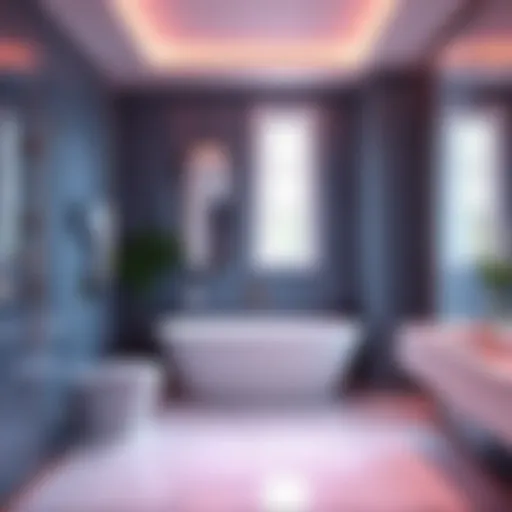Creating a Functional Home Office and Guest Room
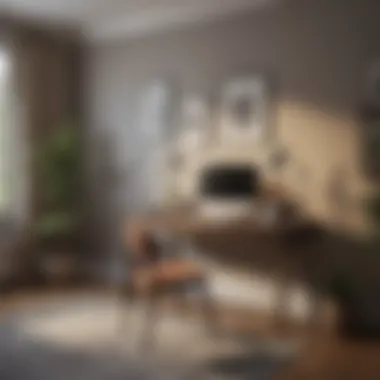
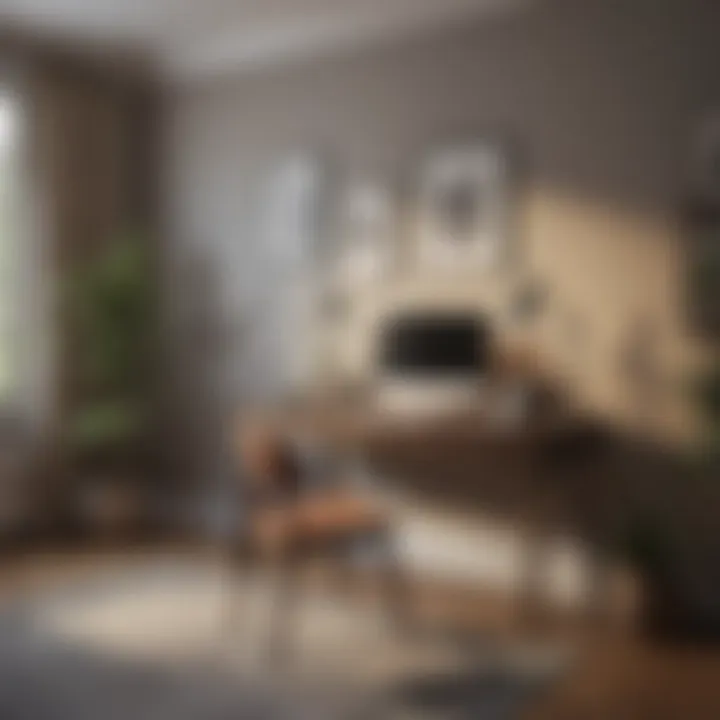
Intro
In today’s fast-paced world, the lines between home and work often blur, and the need for adaptable living spaces has never been more pronounced. A home office that also serves as a guest room can strike that perfect balance, marrying functionality with comfort in a single area of your home. Homeowners and housewives alike can find themselves challenged in making the most out of their available space. This article dives into the essentials of designing a dual-purpose room: considerations that can help create a seamless environment for both professional duties and guest accommodations.
Ultimately, the aim is to ensure that each function—work and leisure—coexists without stepping on each other’s toes. Whether you are planning a small corner in your apartment or a spacious room in a house, transforming a simple space into an efficient office-guest room hybrid can elevate your home’s overall functionality.
Design Inspirations
Creating a dual-purpose space not only requires functionality—it also demands thoughtful design that speaks to your personal style while providing a warm welcome to visitors. Here, we can explore potential design inspirations that can elevate the overall aesthetic of your home office guest room.
Latest Trends in Home Office and Guest Room Design
Current trends lean toward a minimalist approach. Homeowners are moving away from cluttered desks and heavy furnishings, opting instead for cleaner lines and innovative designs that keep the space airy. Here are some trends worth considering:
- Biophilic design: Incorporating plants and natural light helps create a calming environment.
- Zoned spaces: Using rugs or furniture placement to define work and rest areas promotes mental separation.
- Smart home technology: Connecting your workspace to tech solutions can enhance productivity while keeping things functional.
Color Palettes and Themes
Picking the right palette is critical in tying together different functions in a shared space. Harmonious colors create a sense of flow and can greatly impact your mood. For a dual-purpose room, you might consider:
- Neutral tones: Soft grays or beige can serve as a backdrop, allowing for flexibility in decor choices.
- Accent colors: Rich blues or greens can be introduced through decor or office accessories for a refreshing flair.
- Layered textures: Mixing fabrics—such as cotton, linen, or velvet—can add warmth without overwhelming the room’s functionality.
"The best part of designing a dual-purpose space is unleashing your creativity while solving real-life challenges."
In creating this space, take care to ensure the design resonates with you. This connection will not only improve how you interact with the environment but also make your guests feel at home.
Functional Elements
Functionality should never be an afterthought in any space, especially in one meant for multiple uses. Here are some key elements to keep in mind.
Space Optimization Tips
Maximizing space is crucial in a dual-purpose room. Consider these practical guidelines:
- Vertical storage: Utilize shelves or wall-mounted organizers to keep clutter at bay.
- Desk placement: Position your desk near a window to take advantage of natural light and create a pleasant work atmosphere.
- Declutter regularly: Keeping things organized prevents the workspace from feeling cramped when guests arrive.
Multi-Functional Furniture Choices
Selecting the right furniture can significantly impact the usability of your home office guest room. Look for:
- Sofa beds: Perfect for overnight guests, easily converting from seating to a sleeping space.
- Drop-leaf tables: Ideal for a workspace that can expand or contract based on your needs.
- Storage ottomans: They offer extra seating while hiding away blankets, office supplies, or other items out of sight.
In wrapping up this section, keep in mind that function should blend with comfort. Balancing these aspects will help ensure your home office guest room is a place you love both working and unwinding in.
The Contemporary Need for Dual-Purpose Spaces
In today's fast-paced environment, the blend of personal and professional areas within homes is no longer just a trend; it has become a necessity. Designing spaces that serve multiple functions can transform the way we utilize our homes, leading to greater efficiency and comfort. The article tackles this multifaceted topic, focusing on how integrating a home office with a guest room not only optimizes space but also enhances the overall functionality of a living area.
Evolving Home Dynamics
The landscape of home life has shifted significantly in recent years. Homes are evolving from purely functional living spaces into more dynamic environments that adapt to the needs of their inhabitants. Families require rooms that do not solely cater to sleep or work but accommodate diverse activities. This adaptability is particularly essential for housewives and home owners, who often juggle multiple responsibilities and need spaces that can support their lifestyle without cramping their style.
The influence of technology and changing work patterns has also played a part. Homes now serve as the hub for remote work, play, and hosting, requiring a layout that encourages productivity while providing a welcoming atmosphere for guests. As families expand or require more versatile environments, the need for dual-purpose spaces becomes increasingly apparent.
Trends in Remote Work
The rise of remote work has fundamentally altered our approach to home design. A dedicated area for work, whether it’s for a computer setup or a quiet nook to brainstorm, is vital for maintaining productivity. While some folks might opt for a separate office, many others find that the reality of home constraints makes merging functions more practical.
Consider the impact of flexibility. Work from home dynamics allow individuals to tailor their environments to fit their personalities and workflows. Maybe it’s a cozy corner outfitted with a sleek desk from IKEA and an ergonomic chair from Amazon or a more elaborate setup using modular furniture that can easily transition from an office to a guest area. This trend reflects a broader movement toward adaptability—creating spaces that do not merely serve one singular function but can shift alongside the resident's needs.
Guest Accommodation Preferences
It's no secret that guests appreciate hotel-like comforts within a home. However, many homeowners desire an inviting atmosphere without the hefty price tag of maintaining a spare room. The beauty of designing a dual-purpose space is that it effectively meets both the host's and guests' needs. When functionality marries hospitality, the outcome is a welcoming environment that accommodates both sleep and productivity.
Guests today often expect more than just a bed and basic amenities. They look for comfort, accessibility, and a touch of personalization that makes their stay worthwhile. By focusing on adjustable furniture options, such as sofa beds or Murphy beds, a room can easily shift from a vibrant workspace during the day to a restful haven at night. Elements like warm lighting and tasteful decor can create an inviting ambiance, making guests feel at home while ensuring the overall space serves its dual purpose.
The beauty of a dual-purpose space is not just in its function but in how it reflects the personality of the household, making it not only a practical necessity but a canvas for individual style.
By thoughtfully considering these contemporary needs and evolving home dynamics, homeowners can navigate the intricacies of multifunctional designs, ensuring that their spaces serve both as productive work environments and comfortable guest accommodations.
Understanding Functional Requirements
When merging a home office with a guest room, grasping the functional requirements is paramount. This is not just about cramming two roles into one room but ensuring that each purpose complements the other. A well-thought-out space can cater seamlessly to working during the week and welcoming guests over the weekend. Therefore, understanding what is truly needed in each scenario is the starting point.
In this dual-use setting, one must first identify the core functions of each area. A home office traditionally requires a peaceful environment, adequate lighting, easy access to resources, and comfort for extended periods of study or work. On the other hand, a guest room needs to be inviting, comfortable, and equipped with essentials such as bedding, storage, and personal touches that make visitors feel at home. Efficiently blending these requirements not only increases the functionality but also enhances the overall atmosphere of the space.
Identifying the Core Functions
To begin, let's break down the essential functions:
- Work Environment: The office needs a sturdy desk, suitable chair, and technology like computers and printers. Important is also a clutter-free desk that allows concentration.
- Relaxation Space: The guest room part should focus on comfort. A good bed, soft linens, and maybe space for a suitcase or belongings all add to a serene atmosphere.
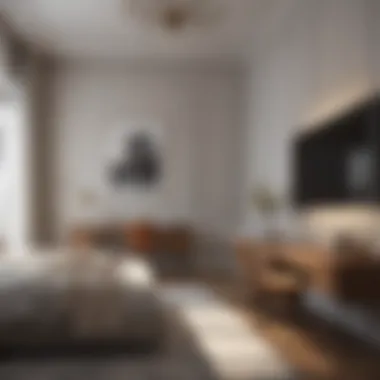
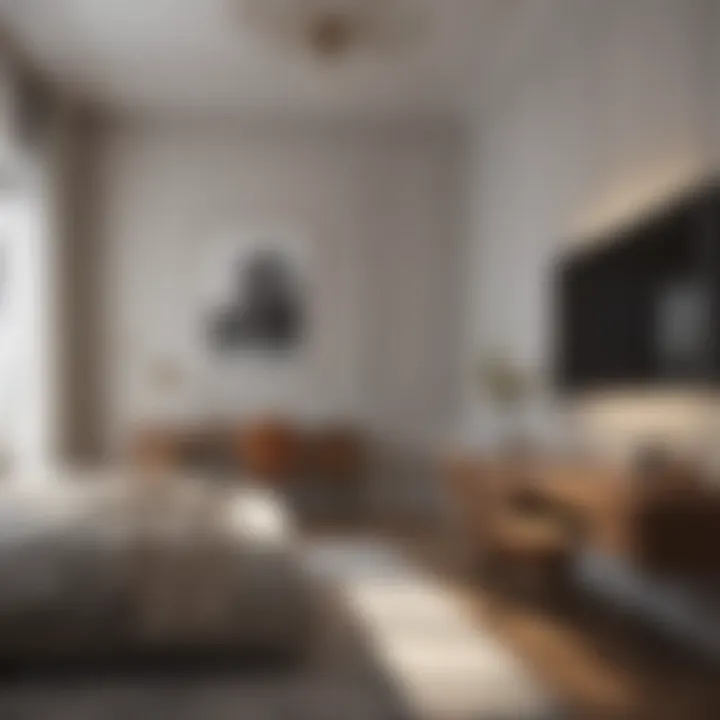
Each choice nudges the design closer to being both productive and welcoming. A well- positioned desk can optimize workflow without making the room feel cramped. Likewise, selecting a bed that can convert into a sofa transforms how the space works at any given moment.
Assessing Space Constraints
Every square inch counts in a dual-purpose room. Assessing space constraints involves measuring not only the physical dimensions but also understanding how the items within the room interact with each other.
Considerations include:
- Physical Size: Measure the length, width, and height of the room. Ensure that furniture fits without causing a squeeze.
- Flow: There should be enough room to move about freely; a guest should not feel as if they are dodging office chairs to get to the bed.
- Natural Features: Look at where windows and doors are placed. Natural light contributes to productivity for the work aspect while also setting a cozy mood for relaxation.
Making the most of limited space may also involve some tricks. Foldable desks, Murphy beds, or ottomans that double as storage can save room without sacrificing comfort or style.
Ultimately, understanding these functional requirements helps craft a space that serves several purposes without feeling disjointed or chaotic. This careful planning pays dividends, offering homeowners a practical yet aesthetically pleasing environment that embodies efficiency and warmth.
Color Schemes That Facilitate Focus and Relaxation
Choosing the right color palette for a dual-purpose room that acts both as a home office and a guest room is a balancing act that can significantly influence mood, productivity, and comfort. Color schemes can either energize or calm, so it’s paramount to select wisely. When designed with intention, colors create an environment where one can focus on work while also winding down after a long day. This section will delve into the significance of color choices and how they can subtly guide the atmosphere of your space.
Neutral Tones as a Base
Neutral tones, such as soft grays, beige, and whites, serve as an excellent base for any dual-purpose room. These colors provide a subtle backdrop that keeps your environment calm and balanced, making them ideal for both concentrated work sessions and welcoming guest stays.
The beauty of neutrals is their versatility. For instance, think about soft gray walls that can harmonize with a variety of decor styles. They're adaptable to both modern and traditional furnishings without clashing. Moreover, neutral tones ensure that any additional accents or decorative pieces won’t feel out of place, maintaining an overall sense of cohesiveness.
In practical terms, light neutral walls can also help a room feel more spacious and airy. This illusion can be especially useful in smaller homes, where every square inch counts. Whether it’s a plush light gray or a warm cream, choosing the right neutral can uplift the atmosphere while keeping it sophisticated.
Incorporating Calming Accents
Once a neutral base is established, the opportunity arises to infuse calming accents that enhance the overall vibe of your home office guest room. Here, shades of blues, greens, and earthy tones can be thoughtfully applied. For instance, consider adding throw pillows in muted sky blue or curtains in a gentle sage green.
These pops of color not only liven up the space but also evoke feelings of tranquility. Studies indicate that colors such as soft blue can lower heart rates and promote a feeling of peace—a perfect complement to a workspace where focus is crucial. Similarly, green is often associated with nature and can bring an earthy touch into your indoor environment.
It’s also worthwhile to think about patterns when selecting these accent colors. Subtle floral or geometric patterns can introduce visual interest without overwhelming the senses. Just a few decorative touches, like a patterned area rug or a canopy of greenery, can elevate the environment while keeping it inviting for guests.
The right blend of neutral tones and calming accents will not only transform the dual-purpose space into an aesthetic sanctuary but will also influence the moods of those who inhabit it.
Selecting the Right Furniture
Choosing the right furniture is a pivotal step in creating a home office that doubles as a guest room. The blend of work and leisure in a single space necessitates thoughtful selection that brings together functionality and comfort. When considering furniture, one must think about flexibility, adaptability, and the overall aesthetic that resonates with both work needs and guest comfort. It’s not just about filling a space; it’s about crafting an environment that serves multiple purposes while keeping the essence of each intact.
Versatile Desk Options
Finding a desk that adapts to both work demands and the occasional guest needs is essential. Look for desks that feature extended tabletops or drop-leaf designs, which can offer ample workspace when needed but can be compacted for more room afterwards. A foldable desk makes sense for those tighter corners or when extra space is required for guest activities. Beyond mechanics, ensure the style of the desk aligns with the overall decor. This way, it serves as a functional piece while maintaining aesthetic continuity.
Some quality desk options include:
- Wall-mounted desks, which save space and can be tucked away seamlessly.
- Standing desks that promote health and well-being by allowing easy transitions between sitting and standing.
- L-shaped desks, which provide expansive working areas without taking up too much floor space.
Comfortable and Stylish Bedding
When it comes to bedding, comfort is key. Your guests should feel at home, even if their visit is brief. Opt for bed frames that incorporate storage underneath, which can hold extra linens or clothing without crowding the room.
Material matters too. Consider hypoallergenic pillows and soft, breathable fabrics. A good-quality mattress is essential; it can transform a night’s sleep, and that’s something guests will surely appreciate. Flip the mattress often to maintain its longevity, maximizing its life span without compromising the comfort.
Multi-functional Pieces
In a squeezed space, dual-purpose furniture truly shines. Furniture that serves more than one function not only saves space but also adds an element of creativity to your decor. Think about ottomans with hidden storage for blankets or coffee tables that can expand to accommodate a larger gathering.
Here’s a breakdown of items that can pull double duty:
- Sofa beds: A classic choice that can transition from a stylish seating arrangement to a restful sleeping area.
- Murphy beds: They fold down into a wall, freeing up floor space when not in use.
- Convertible desks: Some desks can be adjusted in height or can transform from a work surface into a table for guests.
- Nesting tables: Perfect for when you need extra surface area, yet easy to tuck away when you don't.
"Selecting the right furniture is not just about practicality; it’s about creating a space that effortlessly transitions between work mode and relaxation zone."
By curating such furniture, the aim is to establish a fluid living experience that enhances usability while making guests feel welcome and at ease. With intentional choices in desk options, bedding, and multi-functional pieces, the space can truly flourish, harmonizing work with hospitality.
Layout Strategies for Efficiency
Designing a space that serves dual purposes can be a tricky endeavor, requiring a thoughtful approach to layout. Having a clear and effective layout ensures that neither the home office nor the guest room compromises on function or comfort. A purposeful layout promotes efficiency and usability, significantly impacting how space feels and operates.
When embarking on creating this hybrid environment, it’s essential to consider the following aspects:
- Zoning: By delineating areas for work and relaxation, zoning can help maintain focus while allowing a pleasant atmosphere for guests. It can be beneficial to physically separate the desk space from the sleeping area. This visual separation can be achieved through furniture position, area rugs, or even decorative screens.
- Flexibility: Choose furniture that can adapt to your needs. For instance, a foldable desk allows you to maximize space when not in use. It also gives flexibility in terms of rearranging based on the occasion or the number of guests.
- Traffic Flow: Ensuring that movement throughout the space is unhindered is crucial. A thoughtful layout will facilitate a seamless transition from work to rest. This might mean placing the desk in a corner where it’s out of sight from the guest area when entertaining.
Creating Distinct Zones
Creating distinct zones is more than just organizing furniture; it’s about crafting experiences. Think of your home office as a zone where productivity thrives, while the guest room should exude calm and relaxation.
- Define the Work Zone: Position the desk by a window or in a spot that receives adequate natural light. Place ergonomic chairs and accessories like a desk that can accommodate working hours comfortably, utilizing items like desk organizers to reduce clutter.
- Establish the Guest Zone: For the guest area, consider placing the bed in a place that visually and physically separates it from the office. This can be against a wall or even separated by decorative elements like bookshelves. Accentuate this area with personal touches, such as throw pillows and art pieces, making it welcoming and restful.
By clearly defining these zones, both you and your guests can better engage the respective functions of work and sleep without feeling overwhelmed.
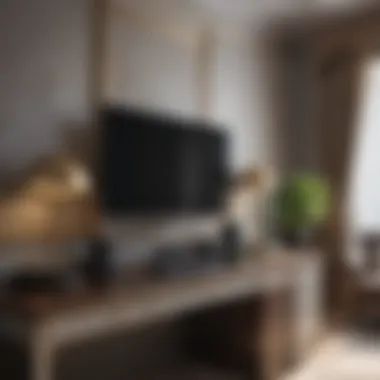
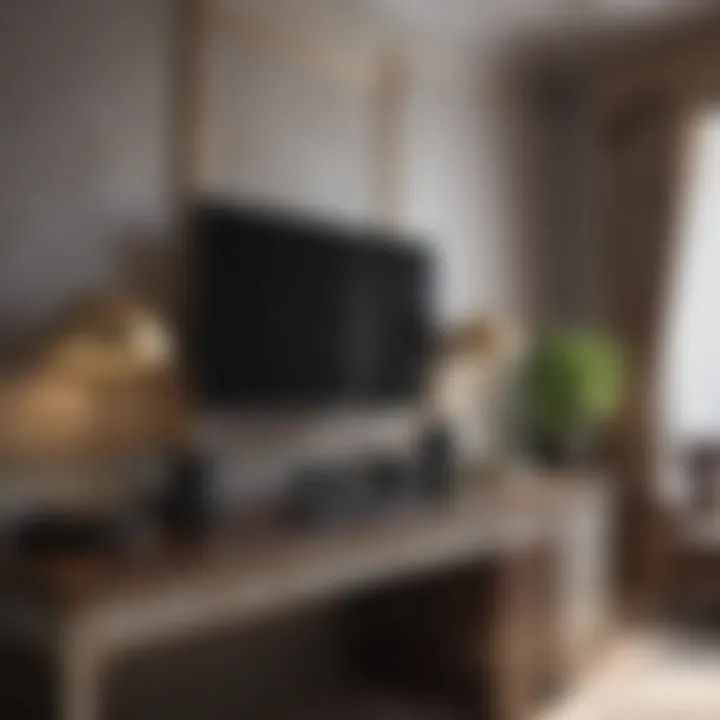
Flow and Accessibility Considerations
Flow and accessibility are the unsung heroes of home design. A space may look fabulous, but if it’s hard to navigate, that’s a design flaw in every sense.
- Ease of Movement: Think about how people will move through the space. Avoid heavy, bulky furniture that could obstruct pathways. Instead, opt for slimline pieces that are functional yet unobtrusive. This promotes a better flow between the office and guest areas.
- Accessibility Needs: Take into account the careers and lifestyles of potential guests. If you often host elderly visitors, keeping pathways clear and furniture at appropriate heights becomes essential for comfort. Also, consider placing frequently used items—like spare blankets or office supplies—within easy reach.
"A well-planned layout can transform the home office guest room from mere utility to harmonious living space, allowing every inch to breathe with purpose."
In summary, effective layout strategies are vital for designing a dual-purpose space that harmonizes work and hospitality. By creating distinct zones and ensuring smooth flow and accessibility, you can craft a tailored environment that meets the needs of everyone who uses it.
Smart Storage Solutions
In designing a dual-purpose space, effective storage solutions play a crucial role in maintaining order and functionality. When the lines between work and rest blur, it’s vital to have a well-thought-out approach to storage. Smart storage can make all the difference, transforming a cluttered environment into a harmonious sanctuary for productivity and relaxation.
Incorporating Built-Ins
Built-in storage solutions are often the unsung heroes of home design. These fixtures can seamlessly integrate with the walls to provide a polished and uncluttered look. Not only do they save floor space, but they also offer ample room for organizing both office supplies and guest essentials.
- Customization: You can tailor built-ins to match your style and space. From shelving units that store books and decor to cabinets that hold office equipment, custom built-ins can cater to your specific needs.
- Visual Appeal: A well-designed built-in can serve as a focal point in the room, enhancing the overall aesthetic. Using materials that blend with the existing decor can tie the space together nicely.
- Maximizing Function: Consider incorporating pull-out trays or hidden compartments in your built-ins. These features keep your items accessible yet discreet, making it easy to switch from work mode to hosting guests.
Utilizing Vertical Space
When space is at a premium, looking up can lead to ingenious solutions. Vertical storage can drastically enhance the room’s functionality without detracting from its charm.
- Wall-Mounted Shelves: Floating shelves can add personality while providing functional space for books, plants, or decorative items. They draw the eye upwards, making the room feel larger and airier.
- Over-Door Storage: Take advantage of door spaces with hooks or small racks for easy access to items like bags or office tools. This keeps everything organized while saving valuable floor space.
- Tall Cabinets: A well-placed tall cabinet can store an array of items from stationery to bedding, ensuring you have everything you need at hand but tucked away neatly.
Under-Bed Storage Techniques
The space under the bed is often overlooked, but it offers a treasure trove of storage potential that can significantly enhance your dual-purpose room.
- Storage Bins: Invest in flat, wheeled storage bins that can slide under the bed. They are perfect for stashing away items that you don’t use daily but still want to keep nearby.
- Roll-Out Drawers: Consider frame designs that allow for easy pull-out drawers, making access to stored items quick and convenient.
- Seasonal Swaps: Use the under-bed area for seasonal items like extra blankets or decorations, freeing up closet space. This not only helps in organization but also ensures that everything has its designated spot.
"Organized storage solutions not just declutter your space but declutter your mind?" Their effectiveness enhances productivity and adds to relaxation.
Ultimately, smart storage solutions in your dual-purpose home office guest room are about more than just where to stash stuff. They give form and function an elegant dance, allowing you to enjoy both work and leisure in a space that feels open and inviting.
Lighting Considerations
When it comes to blending your home office with a guest room, lighting becomes a pivotal factor. Not only does it enhance functionality, but it also sets a particular mood in the space. The right lighting can significantly affect productivity during work hours and create a warm, inviting atmosphere for guests at night. A well-illuminated space can play a vital role in maintaining emotional and mental wellbeing.
Natural Light Maximization
Harnessing natural light is like hitting the jackpot in design. It can boost your mood, make spaces feel larger, and save on energy costs. When planning your dual-purpose area, consider orienting your desk to face a window. This can provide natural light during the day, enhancing your productivity while working and creating a bright setting for guests.
Involve the use of light curtains or shades that allow for flexibility. You want to control light levels without completely blocking out that pleasant sunlight. If direct sunlight isn’t feasible, mirrors can strategically reflect available light, making the room appear brighter. Position a large mirror opposite a window to amplify the light and create an illusion of space. Just imagine waking up with that gentle sunlight flooding in, setting an inviting tone for your guests!
Adjustable Task Lighting
When the day turns to night, dependable task lighting becomes essential, especially in a work environment. Think about incorporating adjustable task lighting to cater to your different needs. A good desk lamp with adjustable brightness can be your best friend. Not only can it provide illuminating support during extended work hours, but it can also set a cozy mood when the office is turned into a guest room.
Consider options like swing-arm lamps or dimmable LED fixtures to ensure full versatility. The goal is to create a comfortable atmosphere for reading or working, without straining the eyes. Here are some aspects to focus on:
- Directional Lighting: Ensure that lights can be pivoted to shine exactly where needed. A lamp that can focus on your work surface will help prevent any eye fatigue.
- Layering: Combine ambient light with task lighting. This helps create depth, ensuring that spaces can feel both functional and homely.
- Multiple Sources: Instead of relying solely on one overhead light, mix in different types of lighting. Floor or table lamps can fill in those shadows that often crop up in a dual-use space.
Creating a Welcoming Atmosphere for Guests
A dual-purpose space needs to be more than just functional; it has to feel inviting and cozy. When designing a home office that also serves as a guest room, the atmosphere is key. A warm and welcoming environment can make guests feel more at home, and it can ease the transition from the functionality of a workspace to the comfort of a sleeping area. This section will outline essential elements that contribute to creating a welcoming atmosphere, exploring the nuances that can enhance the experience for your guests.
Personal Touches in Decor
Personal touches in decor play a significant role in making the space feel homey. Consider incorporating items that reflect your character and style. Here are a few suggestions:
- Family Photos: Framed pictures of family and cherished moments can offer a glimpse of your life, making the space warmer and inviting.
- Local Artwork: Hang a few pieces from local artists. This not only supports the community but adds a unique flair to your room. It reflects an appreciation for creativity which your guests will notice.
- Sentimental Items: Choose a couple of decor items that tell a story or have a special meaning. This could be anything from a trinket from your travels to a handmade piece from a friend. It sparks conversations and builds connections.
These personal touches set a tone of warmth and welcome that helps guests feel at ease.
Essentials for Guest Comfort
To ensure your guests have a pleasant stay, focus on essentials that prioritize comfort. Here are some elements to consider:
- Quality Bedding: Opt for soft bedding, which includes pillows that appeal to different sleeping styles and a cozy duvet. A well-made bed is crucial for a good night's sleep.
- Climate Control: Ensure your guests can regulate the room temperature. Giving them control of the thermostat or providing extra blankets can make the space more comfortable.
- Convenient Storage: Provide space for your guests to store their luggage and belongings. This might be a dedicated drawer or designated shelf. No one wants to live out of a suitcase, after all.
- Basic Amenities: Include essentials like a bedside lamp, alarm clock, and water bottle. Small conveniences can make their experience better and express extra thoughtfulness.
In summary, creating a welcoming atmosphere pivots on the balance between personal touches and comfort essentials. When heading toward that goal, remember that it's about making your guests feel at home, striking that delightful blend of functionality and decor.
"A home is not a place, it's a feeling."
By paying attention to these details, your dual-purpose room can transition seamlessly from an office to a guest sanctuary, ensuring every visitor leaves with a smile.
Emphasizing Aesthetic Appeal
In the quest to create a functional yet inviting space, aesthetic appeal emerges as a pivotal factor in designing a dual-purpose home office and guest room. This isn’t merely about making the space visually pleasing; rather, it draws on the deeper relationship between our environment and our emotional and psychological well-being. A thoughtfully designed area can uplift spirits and bolster productivity while also providing warmth and welcome to guests.
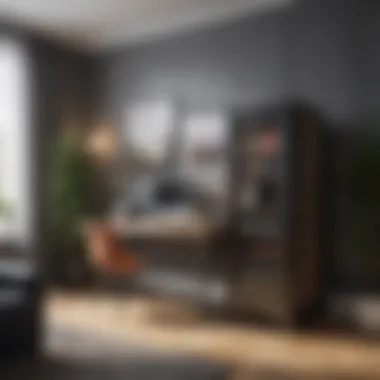

Incorporating Art and Accessories
Art and decorative accessories are the soul of any room. They help tell the story of the inhabitants, reflecting personality, interests, and aspirations. When selecting art for a dual-purpose space, opt for pieces that resonate with both the professional vibe of a home office and the relaxed atmosphere desired for a guest room.
- Wall Art: Large pieces can be a focal point. Consider vibrant paintings or transformative photography that invoke conversation yet remain calm enough not to overwhelm.
- Sculptures and Figurines: Choose unique pieces that can sit on desks or bookshelves, providing a touch of character. Think about materials—wood, metal, or glass can contribute to the overall texture of the room.
- Accessorize Wisely: Use accessories like decorative trays or unique coasters that reflect an eye for detail. Plants can also bridge the gap between both purposes, providing warmth while purifying the air.
A careful blend of art and accessories not only beautifies the space but also can create a harmonious transition between working and welcoming guests.
"The beauty of a room lies not just in its structure but also in what you surround it with."
Textile Choices that Enhance Comfort
Textiles play a significant role in stitching together the aesthetic narrative of a home office guest room. They contribute not only to the comfort level but also to the mood of the space.
- Bedding: Selecting quality comforters or duvets in calming colors can make guests feel at home. Soft linens encourage comfort while also providing a luxurious touch.
- Cushions and Throws: These elements can add layers of coziness. Think plush throws draped over a chair or a medley of cushions on a bed. They invite rest and relaxation, which is crucial when the space must serve dual purposes.
- Rugs: A well-chosen rug can ground the space, defining zones. Choose patterns that are harmonious with your color scheme, keeping in mind to avoid anything too busy that might distract from focus during work hours.
Incorporating textiles that enhance comfort while visually aligning with the overall design enables a seamless blend of functionality and beauty. The space becomes one that feels both productive and restful.
Through the conscious choices of art, accessories, and textiles, a home office guest room can transform into an oasis of both work and relaxation, making it conducive to productivity while still offering a heartfelt welcome to visitors.
Integrating Technology Thoughtfully
Integrating technology into a dual-purpose home office and guest room is not only about selecting the right gadgets; it is about enhancing productivity while ensuring that the guest experience remains comfortable. In today’s busy world, where remote work and hosting guests can overlap, careful consideration of the technology used is key to creating a seamless blend of work and leisure.
Smart Office Gadgets
When it comes to smart office gadgets, think of items that serve multiple functions without overwhelming the space. Wireless charging stations are a prime example. They can sit neatly on a desk or bedside table, avoiding the mess of tangled cords, thereby maintaining a clean aesthetic. Likewise, utilizing smart speakers not only can assist with tasks but also play relaxing music or ambient sounds for guests.
Some other gadgets that can elevate your dual-purpose room include:
- Ergonomic keyboards and mouse: These help maintain comfort during long work hours, ensuring productivity doesn’t dip.
- Adjustable monitors or monitor stands: They can enhance your workstation ergonomically, while also being handy when guests need a space to connect their devices.
- Smart lights: These can adapt to various moods, whether focusing on work or relaxing with guests at the end of the day.
The key here is to select gadgets that can blend into your existing decor, maintaining the room's aesthetic appeal.
Entertainment Options for Guests
A well-thought-out entertainment setup ensures your guests feel at home. Streaming devices, like Roku or Amazon Fire Stick, offer access to numerous films and series. This not only keeps guests entertained after work hours but also means they can unwind comfortably in the space.
Additionally, consider these entertainment options:
- Smart TV: Consider placing a smart television in a good location; it offers versatility for both work presentations and leisure watching.
- Board games or puzzle stations: These can provide a fun, interactive way for guests to unwind while also fostering some light-hearted competitive spirit.
- Bluetooth speakers: Having quality audio for music or podcasts can enhance the atmosphere for both work and relaxation.
In summary, when integrating technology within a dual-purpose room, it is vital to strike a balance between functionality and comfort. Technology should add convenience, facilitate productivity during the workday, and enhance the overall guest experience during their stay.
Maintaining Harmony in Design
Creating a dual-purpose space that serves both as a home office and a guest room is a complex endeavor that necessitates a careful consideration of design harmony. The essence of this balance lies in ensuring that each function of the room can coexist without one overshadowing the other. This is not just an aesthetic choice; it has practical implications for the functionality of the space. A well-designed dual-purpose room must be a seamless interplay between work and relaxation, where each aspect complements the other rather than conflicts.
Achieving Cohesiveness in Decor Styles
To achieve a harmonious design, one must select a decor style that speaks to both functionalities. Whether leaning towards minimalist, contemporary, or eclectic, it’s crucial to maintain a consistent theme throughout the room. This not only enhances the visual appeal but also creates a sense of tranquility that is essential for both work efficiency and guest comfort.
- Colors and Textures: Stick to a color palette that fosters both focus and calmness, with soft neutrals serving as a base. Accents can incorporate textures that invite coziness, such as woven fabrics or plush pillows.
- Unified Furniture Choices: Select furniture pieces that echo the chosen decor style. A stylish desk can double as a bedside table for guests, and sleek shelving can showcase attractive books and decorative items that bridge work and leisure.
- Art Integration: Art plays a significant role in tying together a room's design. Choose artworks that reflect both your professional identity and a welcoming atmosphere. This could mean displaying motivational quotes in your work area while using vibrant landscapes in the guest quarter.
By ensuring that these elements work in tandem, you enable the room to feel intentional and well thought-out.
Balancing Functionality with Aesthetic Elements
The balance between functionality and aesthetics is pivotal. In a dual-purpose setup, the practicality must not come at the expense of style. Each piece of furniture or decor should not only serve a purpose but also enhance the overall vibe of the room.
- Flexible Furniture Solutions: Incorporate multi-functional furniture; a foldout desk can transform into a table for guests, while convertible sofas can provide both seating and sleeping space.
- Practical Layouts: Arrange furniture in a way that allows smooth transitions between work and rest. For example, a desk should be situated near natural light sources, while the bed or sleeping area should allow for privacy and comfort.
- Decorative Accessories: Use aesthetic elements that also serve functions, like decorative boxes for organizing office supplies or a stylish lamp that offers both ambient and focused lighting.
"A well-planned design not only beautifies a space but also enhances its functionality, making the everyday experience simpler and more enjoyable."
By achieving this balance, the room becomes a peaceful sanctuary that promotes productivity during the day and relaxation at night. Overall, maintaining harmony in design ensures that a dual-purpose space remains not only usable but also inviting and reflective of your unique style, benefiting both you and your guests.
Practical Considerations for Regular Use
When contemplating the design of a space serving dual purposes—like a home office and guest room—certain practical considerations must take center stage. The functionality of both work and rest areas relies on careful planning and consideration of how each component interacts. The dynamics of a space that needs to accommodate both tasks and comfort can make or break the experience for anyone using it, be it yourself or your guests.
This section will dive deep into the importance of ergonomic furniture choices and maintaining routine order, which directly influences not just the usability of the space, but also the well-being of its users.
Ensuring Ergonomic Furniture Choices
Opting for ergonomic furniture serves a dual purpose, as it promotes physical well-being and elevates productivity. Proper seating and desk arrangements can proactively prevent strain and discomfort from prolonged usage. When you combine a workspace with a guest room, it’s vital to maintain inclusive designs for both functions.
- Chairs are essential. Look for adjustable chairs that provide lumbar support, allowing users to maintain good posture whether they’re working or unwinding.
- Desks can also be versatile. Height-adjustable desks appeal not only to the office worker needing to shift between sitting and standing but could also be beneficial for guests who may need a space to set up their own workstation.
- Accessories like keyboard trays or footrests can easily be incorporated without compromising your aesthetic vision, making the space comfortable without feeling overly cluttered.
Investing time and resources into ergonomic designs ultimately pays off. It keeps stress at bay while also ensuring that the area remains inviting and functional, regardless of its primary use at a given moment.
Routine Maintenance Tips
Maintaining a dual-purpose space is less about constant cleaning and more about establishing an order that accommodates both productivity and hospitality. Here are some tips to streamline upkeep without compromising style:
- Regular Decluttering: Make it a habit to clear away items that aren’t in use. It’s easy to let papers, office supplies, or even guest bedding pile up. Establish a routine—perhaps every end of the week—to sort through what you no longer need.
- Simple Solutions: Implementing easy-to-reach storage solutions reduces stress. Boxes or organizers can keep clutter hidden yet accessible. Wall-mounted shelves are another great asset; they offer visibility without the mess.
- Cleaning Schedule: Develop a cleaning routine that addresses the room’s differing needs. For instance, one day could focus on dusting the office area, while another could prioritize freshening up the guest side with linens and a quick vacuum.
"A little planning goes a long way in maintaining the harmony of a dual-purpose space. Regular attention prevents chaos, ensuring comfort for both work and visitors."
It's the small actions, repeated over time, that help sustain a well-functioning, dual-purpose environment. To bring everything together, frequent updates on decor or minor adjustments can also breathe life into the space, keeping it engaging and pleasant for both hosts and guests.











